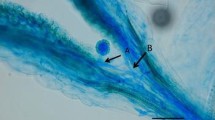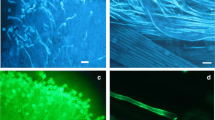Abstract
Incompatible (self) pollen tube growth in styles of six cultivars of L. longiflorum is strikingly influenced by treatment of the styles for six minutes in 50°C distilled water prior to pollination. In pretreated detached styles the incompatible pollen tubes reach lengths normally attained by compatible pollen whereas in untreated styles they grow to only approximately two-thirds the length normally reached by compatible tubes. Pretreatment at either 25°C or 45°C for six minutes does not affect incompatible pollen tube growth. Both compatible and incompatible tubes grow only a few millimeters into styles treated at 55°C for six minutes. Stigmatoid cells in these styles appear necrotic. Pretreatment of attached styles at 50°C for six minutes resulted in fruit set following self-pollination. Seed number per capsule ranged from 6 to 114. Stylar pretreatment appears to be a highly promising approach to further investigation concerning the nature of the self-incompatibility reaction. It also appears to offer a suitable means of obtaining seed from self-incompatible plants.
Similar content being viewed by others
References
Ascher, Peter D., 1966. A gene action model to explain gametophytic self-incompatibility. Euphytica 15: 179–183.
Ascher, Peter D. and Peloquin, S. J., 1966. Effect of floral aging on the growth of compatible and incompatible pollen tubes in Lilium longiflorum. Amer. J. Bot. 53: 99–102.
Bali, P. N., 1963. Some experimental studies on the self-incompatibility of Oenothera rhombipetala Nutt. Phyton. 20(2): 97–103.
Bali, P. N. and Hecht, A., 1965. The genetics of self-incompatibility in Oenothera rhombipetala. Genetica 36: 159–171.
East, E. M., 1929. Self-sterility. Bibliography Genet. 5: 331–368.
Hecht, A., 1964. Partial inactivation of an incompatibility substance in the stigmas and styles of Oenothera, p. 237–243. In: H. F. Linskens, Pollen Physiology and Fertilization. North-Holland, Publ. Comp., Amsterdam.
Kumar, S. and Hecht, A., 1965. Inactivation of incompatibility in Oenothera organensis following ultraviolet irradiation. Naturwissenschaften 13: 398–399.
Lewis, D., 1942. The physiology of incompatibility. I—The effect of temperature. Proc. Roy. Soc. (London) B131: 13–26.
Lewis, D., 1954. Comparative incompatibility in angiosperms and fungi. Adv. in Genet. 6: 235–285.
Lewis, D., 1964. A protein dimer hypothesis on incompatibility. Genetics Today. 3: 657.
Linskens, H. F., 1964. Biochemistry of incompatibility. Genetics Today. 3: 629.
Linskens, H. F., Schrauwen, J. A. M. and van den Donk, M.,1960 Überwindung der Selbstinkompatibilität durch Röntgenbestrahlung des Griffels. Naturwissenschaften 47: 547.
Modlibowska, I., 1945. Pollen tube growth and embryo-sac development in apples and pears. J. Pomol. Hort. Sci. 21: 57–89.
Author information
Authors and Affiliations
Additional information
Paper No. 1096 from the Laboratory of Genetics, University of Wisconsin. Supported in part by a grant from the National Science Foundation.
Rights and permissions
About this article
Cite this article
Hopper, J.E., Ascher, P.D. & Peloquin, S.J. Inactivation of self-incompatibility following temperature pretreatments of styles in Lilium longiflorum . Euphytica 16, 215–220 (1967). https://doi.org/10.1007/BF00043457
Received:
Issue Date:
DOI: https://doi.org/10.1007/BF00043457




